Your Guide to Call Center Compliance Monitoring Essentials
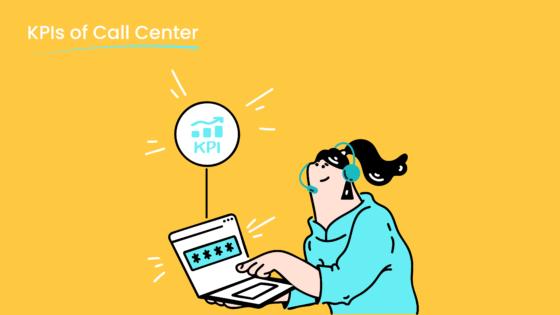
Call center compliance monitoring protects your business and builds customer trust. When you follow a strong compliance checklist, you help keep customer data safe and avoid costly mistakes. Non-compliance can cause fines of up to $100,000 per month for PCI DSS violations and even higher for GDPR. You can see how these costs add up in the chart below.
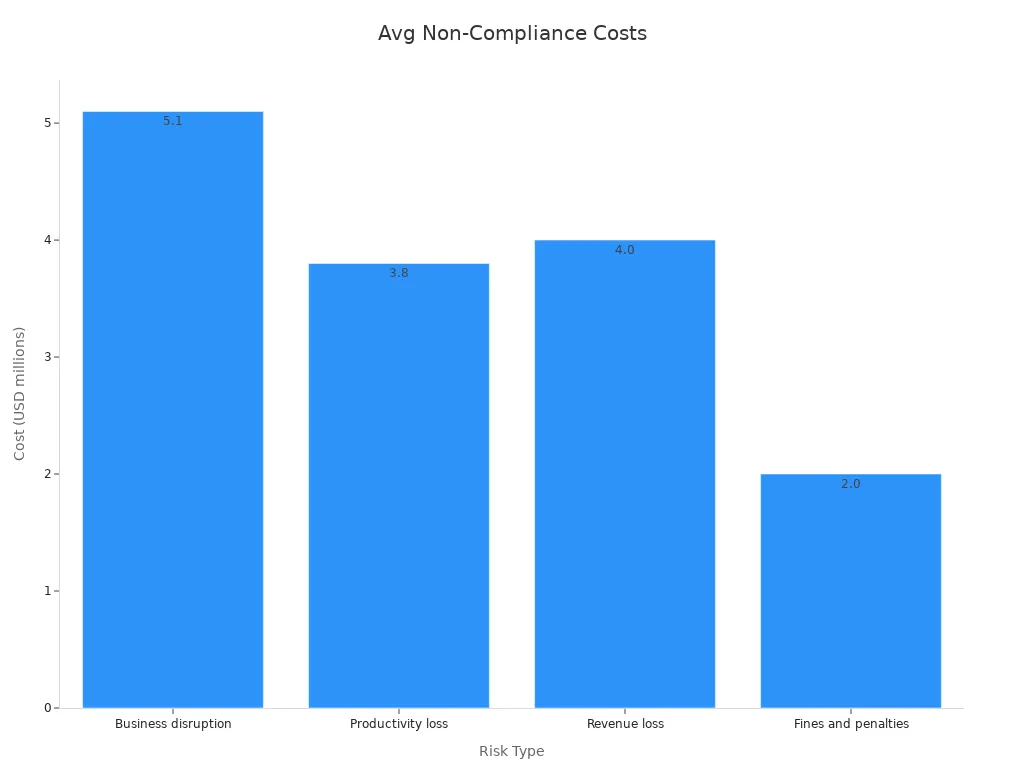
Many call centers use AI tools like Sobot AI to track key compliance metrics and improve results. Use the checklist here to measure your own call center compliance and stay ahead of risks.
Compliance Monitoring Basics
What Is Call Center Compliance?
You need to follow call center compliance rules to protect your business and your customers. Call center compliance means you meet all legal, industry, and company requirements when you handle customer calls. These requirements cover how you collect, store, and use customer data. You must also follow rules about call recording, agent behavior, and data privacy regulations like GDPR and CCPA.
Call center compliance monitoring helps you check if your team follows these requirements every day. You can use tools like Sobot’s Voice/Call Center to track calls, store data securely, and make sure agents follow the right steps. If you do not meet compliance requirements, you risk fines, lawsuits, and loss of customer trust. For example, GDPR fines can reach up to €20 million or 4% of annual revenue, whichever is higher (source). Good compliance monitoring keeps your call center safe and builds trust with your customers.
Key Regulations
You must understand the main regulations that affect call center compliance. These regulations set the requirements for how you handle calls, protect data, and resolve disputes. Here are some of the most important regulations:
- Do Not Call (DNC) Regulations: Customers can opt out of telemarketing calls. You must respect their choice or face fines.
- Telemarketing Sales Rule (TSR): Sets requirements for call timing, disclosures, and payment methods.
- Service Level Agreements (SLAs): Define requirements for call response times and resolution rates.
- Indemnification Clauses: Explain who is responsible for legal issues or data breaches.
- Termination Rights and Obligations: Outline how to end contracts if compliance is not met.
- Dispute Resolution Mechanisms: Set steps for handling conflicts.
- Intellectual Property Protection: Use NDAs to protect sensitive information.
You also need to follow data privacy regulations like GDPR and CCPA. GDPR compliance means you must get consent before collecting data, keep data secure, and let customers access or delete their information. Sobot’s call center solutions help you meet these requirements with secure data storage and real-time monitoring.
Compliance Checklist
A strong compliance checklist helps you meet all requirements and avoid costly mistakes. Use this checklist to guide your call center operations and protect your business.
Consent and Privacy
You must always get clear consent before collecting or using customer data. This step builds trust and meets legal requirements. A recent survey of 3,539 US adults found that privacy protections, like proper consent and transparency, make people more willing to share their information. When you explain why you collect data and how you use it, customers feel safer.
Actionable Steps:
- Ask for consent before recording calls or collecting personal data.
- Use clear language for all mandatory disclosures about data use.
- Let customers know how to access, update, or delete their information.
- Store consent records securely for audits.
Sobot’s Voice/Call Center makes it easy to manage consent. You can set up automated prompts for disclosures and track consent in the unified workspace. This helps you meet compliance requirements and keeps your records organized.
Tip: Always review your consent process to make sure it matches current laws and company policy.
DNC List Management
Managing Do Not Call (DNC) lists is a key part of your compliance checklist. The DNC Registry protects consumers from unwanted calls. You must respect these lists to avoid fines and build trust.
- The DNC Registry is managed by the FTC and blocks unsolicited sales calls.
- You must keep your own internal DNC list for customers who ask not to be contacted.
- Some states have their own DNC rules, so check both federal and state requirements.
- Fines for violations can reach $43,792 per call under the Telemarketing Sales Rule.
Actionable Steps:
- Scrub your contact lists daily against national and internal DNC registries.
- Use automated systems, like Sobot’s Voice/Call Center, to update lists and block calls to DNC numbers.
- Train staff to honor opt-out requests right away and log them in your system.
- Avoid auto-dialed or prerecorded calls to DNC numbers.
Keeping your DNC lists current protects your call center from legal risks and keeps your brand reputation strong.
Data Security
Data security is a top priority in your compliance checklist. You must protect customer data from leaks and unauthorized access. Strong data security also supports compliance with laws like GDPR and PCI DSS.
| Security Measure | Description | Outcome / Metric |
|---|---|---|
| Data encryption, anomaly detection, automated redaction | Protects sensitive data and supports compliance | 40% reduction in compliance costs; fewer errors |
| Multi-factor authentication | Adds extra security for agent logins | Improved operational efficiency |
| Role-based access controls | Limits data access to only those who need it | 10% increase in security effectiveness |
Actionable Steps:
- Use encrypted storage for all customer data and call recordings.
- Set up multi-factor authentication for agent and admin accounts.
- Limit access to sensitive data using role-based controls.
- Run regular audits to check for security gaps.
- Train staff on data security best practices.
Sobot’s Voice/Call Center uses encrypted data transfer and secure storage. You can manage access controls and monitor activity in real time. These features help you meet compliance requirements and keep your data safe.
Call Recording
Call recordings are essential for quality assurance and compliance monitoring. You must follow legal requirements for call recording compliance, including getting consent and storing recordings securely.
- Real-time call monitoring and coaching improve agent skills and compliance.
- Recorded calls help you track performance, verify disclosures, and provide audit trails.
- AI tools can analyze all recordings, flagging issues for review.
- The global call tracking software market is growing fast, showing the importance of call recording in business (source).
Actionable Steps:
- Inform customers and agents when calls are being recorded.
- Store recordings securely with access controls.
- Use AI-powered tools, like those in Sobot’s Voice/Call Center, to review 100% of recordings for compliance issues.
- Provide immediate feedback to agents on missed mandatory disclosures or other problems.
- Keep recordings for the required time period to support audits.
Regularly review your call recording policy to ensure it matches legal requirements and company standards.
Agent Training
Agent training is a vital part of your compliance checklist. Well-trained agents know how to handle disclosures, follow scripts, and protect customer data. Structured compliance training leads to better compliance outcomes and fewer violations.
- Script compliance audits help you find training gaps and fix them.
- Advanced auditing tools give real-time feedback and track agent performance.
- Regular refresher courses keep agents up to date on new requirements.
- Detailed training records support audits and show your commitment to compliance.
Actionable Steps:
- Provide role-specific compliance training for all agents.
- Use blended learning methods, such as e-learning, shadowing, and simulations.
- Run regular script compliance audits and give feedback to agents.
- Keep detailed records of all training sessions and updates.
- Use Sobot’s Voice/Call Center agent training modules to deliver and track training.
Weee!, America’s largest online Asian supermarket, improved agent efficiency by 20% and cut resolution time by 50% after using Sobot’s flexible IVR and training tools. Their customer satisfaction score reached 96%, showing the power of a strong compliance checklist and ongoing training.
Checklist Recap:
- Get and document consent for all data collection and recordings.
- Maintain and update DNC lists daily.
- Secure all data with encryption and access controls.
- Record calls with proper disclosures and review them regularly.
- Train agents on compliance requirements and keep records of all training.
A compliance checklist, combined with technology and training, helps you meet all requirements, reduce risks, and build customer trust.
Technology in Call Center Compliance Monitoring
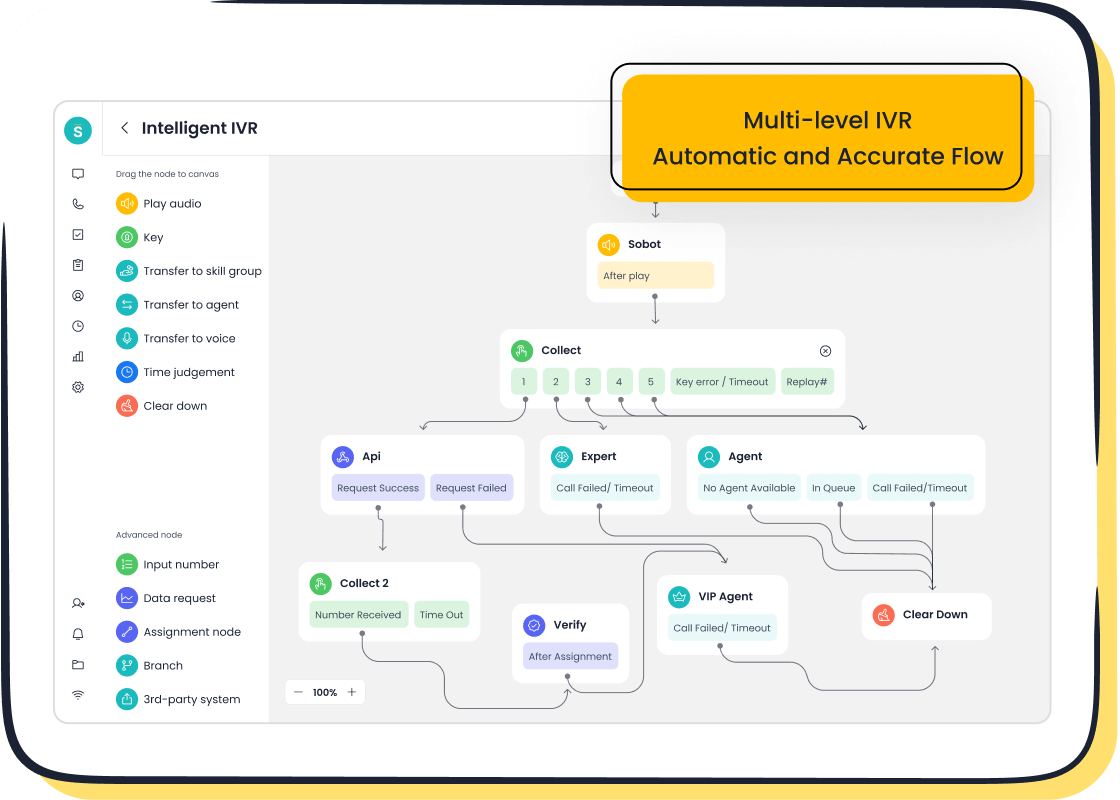
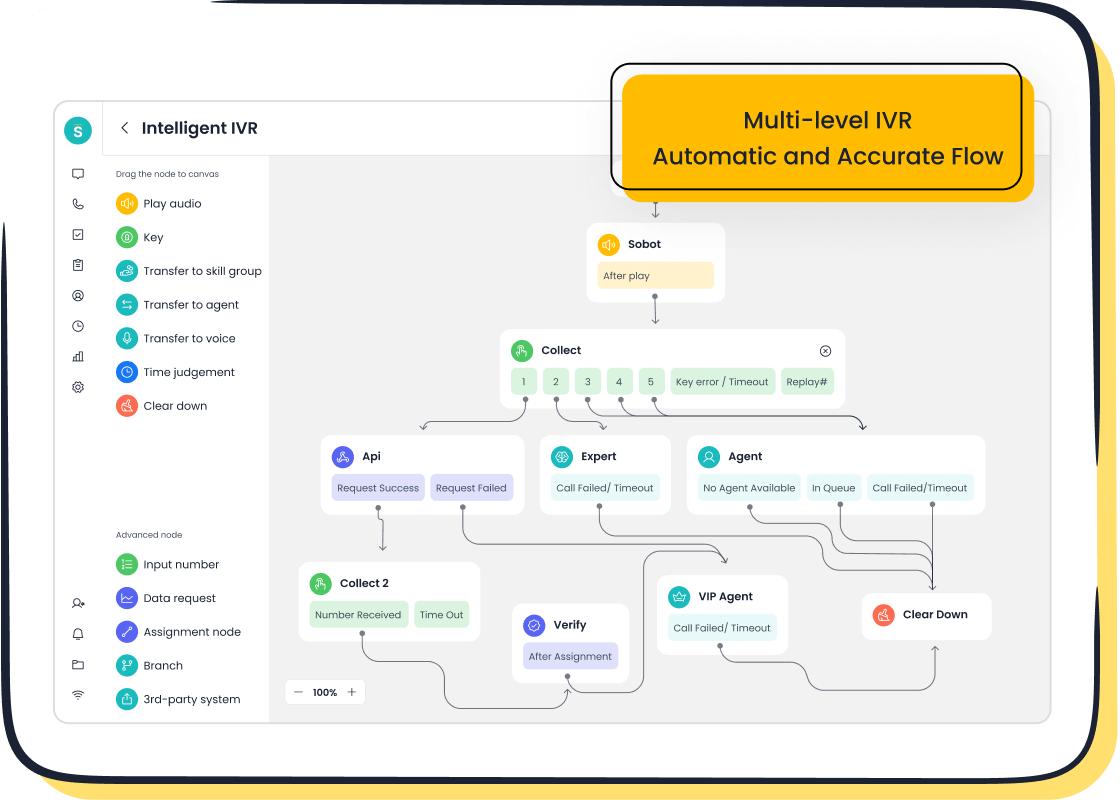
Sobot Voice/Call Center Tools
You need reliable technology to keep your call center compliant. Sobot’s Voice/Call Center gives you real-time monitoring, secure data storage, and AI-powered analytics. These tools help you track every call, manage recordings, and protect customer data. With Sobot, you can set up smart call routing, use encrypted storage, and control access with multi-factor authentication. The system supports global operations with 99.99% uptime, so your compliance efforts never stop. You can also manage agent performance and review recordings easily in one unified workspace.
Sobot’s secure platform helps you meet regulations like GDPR and PCI DSS. You can store recordings safely and use AI to spot compliance issues fast.
Automated Monitoring
Automated monitoring changes how you handle compliance in your call center. Instead of checking only a few calls, you can now review 100% of your recordings. AI-driven tools analyze calls in real time, flagging any compliance risks or missed disclosures. This approach reduces manual work and catches more issues. For example, organizations using automated monitoring saw an 85% drop in manual reviews and a 30% boost in violation detection. You also get instant feedback for agents, which improves training and reduces compliance breaches.
- Most call centers used to check only 1-3% of calls. Automated systems now let you monitor every call and every recording.
- AI tools can measure agent behavior, track authentication steps, and ensure all compliance rules are followed.
Integration and Analytics
Integration and analytics make compliance monitoring even stronger. Sobot’s Voice/Call Center connects with your CRM and other business tools, so you can manage data and recordings in one place. Advanced analytics give you insights into agent performance, customer satisfaction, and compliance trends. You can spot gaps, run targeted training, and keep your call center ready for audits.
- AI-powered analytics help you find compliance risks quickly.
- Automated reports reduce errors and make audits easier.
- Integration with cloud systems ensures secure authentication and centralized control.
| Technology Tool | Compliance Improvement Example | Quantitative Impact |
|---|---|---|
| Automated Monitoring | 100% call and recording review | 85% less manual review, 30% more violations detected |
| AI Analytics | Real-time compliance risk detection | 600% more agent feedback, fewer breaches |
| Secure Integration | Centralized authentication and storage | 99.99% uptime, fast audit response |
Using Sobot’s integrated tools, you can build a culture of compliance, reduce risks, and improve customer trust in your call center.
Industry-Specific Compliance
Financial Services
You face some of the strictest regulations in the financial services industry. Your call center must follow many requirements to protect customer data and avoid penalties.
- PCI DSS rules say you cannot store sensitive cardholder data like CVV2 or PINs.
- You must inform customers about call recording and get their consent.
- The Telephone Consumer Protection Act (TCPA) limits telemarketing calls and requires you to honor do-not-call requests.
- The Gramm-Leach-Bliley Act (GLBA) demands strong access controls, encryption, and regular employee training.
- State laws may set extra rules for call recording and monitoring.
If you do not meet these requirements, you risk fines, legal action, and damage to your reputation. Many financial call centers use call monitoring, agent coaching, and compliance scoring to stay on track. Sobot’s Voice/Call Center helps you meet these regulations with secure data storage, real-time monitoring, and redaction tools.
Regular audits and technology updates help you keep up with changing regulations and compliance needs.
Healthcare
Healthcare call centers must protect patient privacy at all times. HIPAA regulations require you to keep all patient information confidential and secure. You need to use encryption and train agents in medical terms and crisis response.
- HIPAA sets strict requirements for data handling and agent behavior.
- You must use secure channels for all communications.
- Agents need special training to handle sensitive health information.
Your call center should use technology that supports encryption and secure storage. Sobot’s solutions help you meet these requirements by offering encrypted data transfer and detailed access controls. Regular audits and ongoing training keep your team ready for any compliance challenge.
Patient trust depends on your ability to meet all privacy and security regulations.
Retail and E-Commerce
Retail and e-commerce call centers face unique compliance challenges. You must protect customer data, process payments securely, and scale operations during busy times.
- Data protection laws like GDPR and CCPA set strict requirements for handling customer information.
- You need secure payment processing and real-time inventory integration.
- Service consistency is key, even during peak periods.
Sobot’s AI-powered solutions help you manage these requirements. You can automate compliance checks, monitor agent performance, and keep customer data safe. For example, Sobot’s platform supports GDPR compliance with encrypted storage and automated consent tracking. Regular audits and analytics help you spot risks and improve your processes.
A strong compliance program builds customer trust and keeps your business running smoothly.
Quality Assurance and Audit Trails
Call Monitoring
You need strong call monitoring to achieve quality assurance in your call center. This process checks if agents meet company standards and follow compliance rules. You can use call audit tools to review agent performance and spot areas for improvement. Many call centers set up a dedicated quality assurance team to oversee this process.
- Auditing ensures agents meet performance benchmarks, which keeps customer experience consistent.
- Auditors identify performance gaps, so you can target agent improvement.
- Auditing gives management insights by reviewing calls from multiple agents.
- Manual audits often cover only 1-2% of calls, which can miss important issues.
- Automated auditing tools, like those in Sobot’s Voice/Call Center, enable 100% call audit coverage and eliminate sampling bias.
You can use dashboards to track key metrics such as First Call Resolution and Customer Satisfaction Score. These tools help you maintain high assurance standards and improve compliance.
Tip: Involve agents in the quality monitoring process to boost morale and gain valuable feedback.
Documentation
Accurate documentation supports every audit and compliance review. You should keep detailed records of all calls, agent actions, and audit findings. This practice helps you show regulators that you follow compliance rules.
- Use call audit scorecards to record evaluations.
- Store audit results and reviews in a secure system.
- Share quality assurance findings with your team to drive improvement.
Sobot’s unified workspace lets you manage documentation and audit trails in one place. This makes audits and compliance reviews faster and more reliable.
Incident Response
A strong incident response plan protects your call center during a compliance breach. You need to prepare, detect, contain, and recover from incidents quickly.
- Develop clear policies and procedures for incident response.
- Use continuous monitoring and automation to detect breaches.
- Notify stakeholders using pre-approved templates.
- Apply remediation measures, such as technical fixes or credit monitoring.
- Conduct post-incident reviews to update your plan and training.
Regular simulated testing, like breach response drills, helps you improve your plan. Sobot’s secure data storage and real-time monitoring support your incident response efforts and keep your audit trails complete.
Note: Post-incident reviews help you learn from each event and strengthen your compliance program.
Red Flags and Solutions
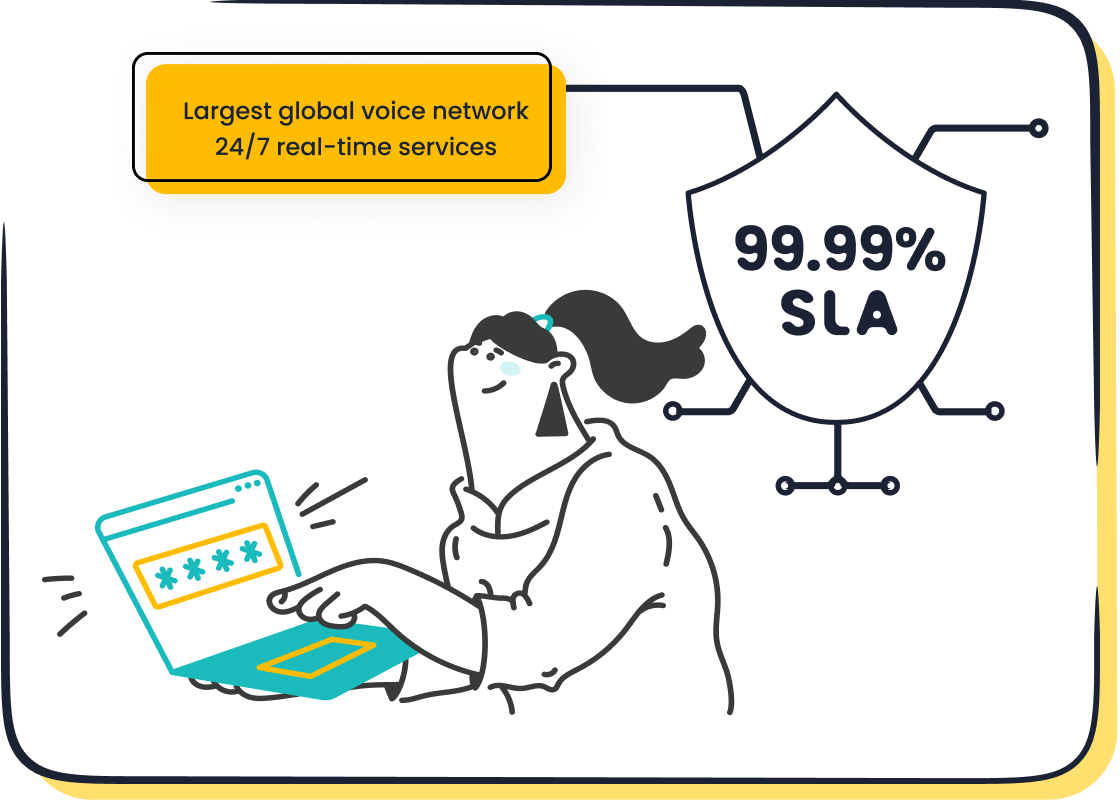
Common Issues
You may notice several warning signs that your call center faces compliance risks. High agent turnover, unclear pricing, and frequent fines for calling numbers on the Do Not Call list all signal deeper problems. Many call centers see an average agent turnover rate of 42%. This instability can hurt service quality and increase costs. If your team lacks transparency in contracts or pricing, you risk losing customer trust. Fines for DNC violations can reach $40,000 per call, which adds up quickly if you do not follow regulations.
Advanced call centers use AI and machine learning to spot subtle patterns in calls. These tools detect changes in vocal tone, inconsistencies, and repetitive claims. Emotional tone detection helps you catch suspicious behavior early. Real-time alerts let you act before small issues become big problems.
| Red Flag Category | Metric / Indicator | Impact |
|---|---|---|
| Agent Turnover Rate | 42% average | Instability, higher costs |
| DNC Violations | Up to $40,000 per call | Heavy financial penalties |
| Access Controls | Unique login IDs | Prevents unauthorized data access |
| Fraud Detection | AI/ML pattern analysis | Early fraud and compliance risk detection |
Tip: Regular audits and reviews help you catch these issues before they lead to bigger compliance failures.
How to Fix
You can address these red flags with a few focused steps. Start by running frequent audits of your call center processes. Use technology like Sobot’s Voice/Call Center to automate monitoring and flag compliance risks in real time. Set up unique login IDs for every agent to improve traceability and prevent unauthorized access. Make sure you update your DNC lists daily and train agents to follow all regulations.
Automated tools can review every call, not just a small sample. This approach gives you a complete picture of your compliance status. Schedule regular reviews of your training programs and update them as regulations change. Sobot’s unified workspace makes it easy to manage audit trails and documentation, so you stay ready for any compliance review.
Stay proactive. Frequent audits, strong access controls, and real-time monitoring keep your call center compliant and your customers safe.
You gain many advantages when you follow a strong checklist in your call center. You protect customer data, reduce legal risks, and build trust. Sobot’s Voice/Call Center helps you meet industry standards and improve quality.
| Benefit | Description |
|---|---|
| Risk Reduction | Fewer fines and legal issues |
| Customer Trust | Better satisfaction and loyalty |
| Quality Assurance | Higher agent performance and call quality |
Take the next step by reviewing your current process or exploring Sobot’s solutions for ongoing improvement.
FAQ
What is call center compliance monitoring?
Call center compliance monitoring means you check if your team follows rules and laws during calls. You protect customer data and avoid fines. Sobot’s Voice/Call Center helps you track calls, store data safely, and review agent actions for better compliance.
Why is call center compliance monitoring important?
You need call center compliance monitoring to avoid legal trouble and build trust. Fines for non-compliance can reach $100,000 per month for PCI DSS violations (source). Good monitoring keeps your business safe and your customers happy.
How does Sobot help with call center compliance monitoring?
Sobot’s Voice/Call Center offers real-time monitoring, encrypted data storage, and AI-powered analytics. You can review every call, manage agent training, and keep audit trails. These features make call center compliance monitoring easier and more reliable.
What are common mistakes in call center compliance monitoring?
You might forget to update Do Not Call lists, miss consent disclosures, or skip regular audits. These mistakes can lead to fines or lost trust. Automated tools like Sobot’s Voice/Call Center help you avoid these problems by checking every call and keeping records.
How often should you review your call center compliance monitoring process?
You should review your call center compliance monitoring process at least every quarter. Regular reviews help you spot risks, update training, and follow new laws. Sobot’s analytics and reporting tools make these reviews simple and fast.
See Also
Essential Principles For Implementing Call Center QMS
Top Strategies For Effective Call Center Quality Management
Comprehensive Overview Of Quality Assurance Tools For Call Centers
